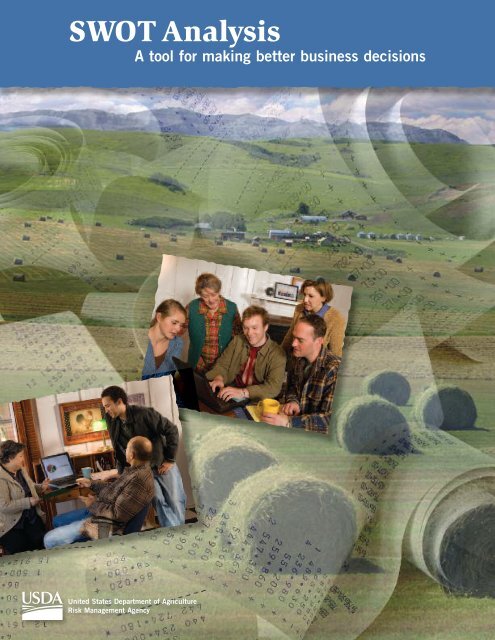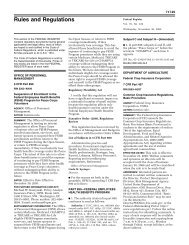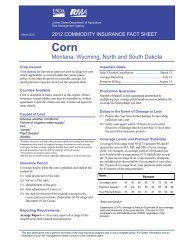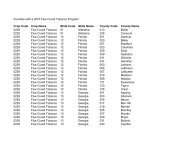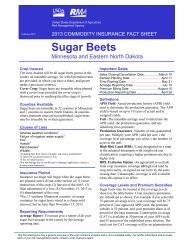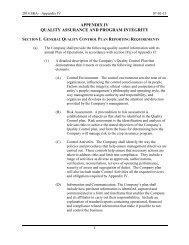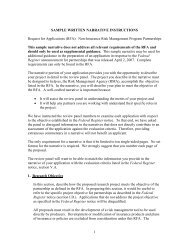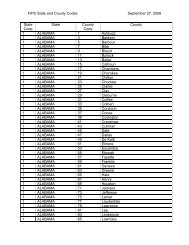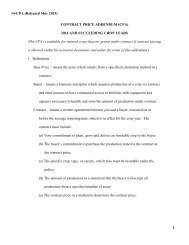SWOT Analysis - RMA USDA Risk Management Agency - US ...
SWOT Analysis - RMA USDA Risk Management Agency - US ...
SWOT Analysis - RMA USDA Risk Management Agency - US ...
You also want an ePaper? Increase the reach of your titles
YUMPU automatically turns print PDFs into web optimized ePapers that Google loves.
<strong>SWOT</strong> <strong>Analysis</strong><br />
A tool for making better business decisions<br />
United States Department of Agriculture<br />
<strong>Risk</strong> <strong>Management</strong> <strong>Agency</strong>
2<br />
What’s a <strong>SWOT</strong> analysis?<br />
A <strong>SWOT</strong> analysis is a tool that helps you evaluate the Strengths, Weaknesses, Opportunities,<br />
and Threats (<strong>SWOT</strong>) involved in any business enterprise — including farms and ranches.<br />
A <strong>SWOT</strong> analysis can help you gain insights into the past and think of possible solutions<br />
to existing or potential problems — either for an existing business or new venture. For a<br />
<strong>SWOT</strong> analysis to work well, every member of your team (your family and/or employees,<br />
lawyer, accountant, and insurance agent) should be involved in the process.<br />
After you read this overview, you will find a description of a sample farm and have a<br />
chance to go through a <strong>SWOT</strong> analysis for it. This exercise should help prepare you for<br />
doing your own <strong>SWOT</strong> analysis.<br />
you in this venture. You may lack qualified<br />
employees, or perhaps your business will<br />
not support full-time employees. If you<br />
identify these as weaknesses, don’t worry<br />
because existing businesses may have<br />
similar weaknesses.<br />
Strengths<br />
Strengths are considered mostly internal.<br />
For example, what do you and your family,<br />
employees, and management team bring<br />
to the business? If you are planning to start<br />
a business, you or an employee or family<br />
member may have previous experience in<br />
that industry. If not, this may be viewed as<br />
a weakness. If you already know where to<br />
go to find the help you need, this would be<br />
considered a strength for this analysis.<br />
Weaknesses<br />
Weaknesses are also generally considered<br />
internal and are the factors you will need<br />
to address to run a successful business.<br />
For a start-up business, an example might<br />
be a lack of experience in the selected<br />
industry. Another example may be that your<br />
family members do not completely support<br />
Opportunities<br />
Opportunities are considered mostly external.<br />
What opportunities are available for your<br />
business? You may be able to take advantage<br />
of low interest loan packages for start-ups<br />
or grants for feasibility studies. You may<br />
have an idea that has not been tried in your<br />
area and know there is a demand for the<br />
product you plan to produce. Be aware that<br />
people with potential businesses tend to be<br />
much more optimistic than those with<br />
existing operations.<br />
Threats<br />
Threats are also considered mostly external.<br />
Threats from outside of your business will<br />
directly affect you, but you may have very<br />
little control over them. If you are starting a<br />
new business, there may be local regulations<br />
that negatively impact your business.<br />
Unforeseen competition (local or foreign),<br />
dissolution of markets, and adverse weather<br />
may also have a negative effect on your<br />
new business. Many of these threats will<br />
also negatively affect an existing business.<br />
Rising interest rates may have a greater impact<br />
on existing businesses than on start-ups.
3<br />
When conducting your <strong>SWOT</strong> analysis,<br />
keep in mind that one item can offset<br />
another. For example, your strengths may<br />
counterbalance your weaknesses and your<br />
opportunities can offset your threats. If this<br />
does not happen, this exercise will help you<br />
to understand the issues you need to address.<br />
Some things to consider.<br />
Human Resources<br />
Hiring employees who have the skills you<br />
deem necessary is one way to combat a<br />
weakness. For example, if you need someone<br />
to drive a large truck, hiring someone with<br />
a commercial driver’s license will eliminate<br />
that weakness. Or, you could learn how to<br />
drive the truck yourself — but can you<br />
spare the time away from the business?<br />
Adding to your management team is another<br />
way to eliminate a potential weakness.<br />
If your business is growing and you are<br />
handling the bookkeeping tasks yourself,<br />
hiring a bookkeeper will free up your time<br />
to focus on other parts of the business.<br />
If you do, be sure to hire someone you trust<br />
or do an extensive background check —<br />
especially if they will have check-signing<br />
capabilities. Having that person bonded will<br />
also create a level of security.
4<br />
Insurance<br />
For many agricultural businesses, insurance<br />
is a way to eliminate possible weaknesses,<br />
threats, or risks. If your analysis shows that<br />
you are undercapitalized to handle a major<br />
emergency (as are most agricultural<br />
businesses), insurance coverage will help<br />
eliminate this issue. Threats from liability,<br />
fire, automobile accidents, and crop failures<br />
can all be reduced with proper insurance.<br />
Liability insurance<br />
Liability insurance covers anyone who is<br />
injured on your farm. This coverage is<br />
included on your farm owner’s policy, but<br />
the coverage is only for the dollar amount<br />
listed on the policy. For example, if your<br />
liability limit is $500,000 and someone sues<br />
you for $1 million, you will only be covered<br />
for the $500,000. The remainder of the<br />
judgment award is your responsibility.<br />
You should review your risk level with<br />
your insurance agent.<br />
Fire insurance<br />
Fire insurance is<br />
also included on<br />
your farm<br />
owner’s policy.<br />
You may choose<br />
to insure some<br />
buildings, but not<br />
all. The level at<br />
which you will<br />
be reimbursed is written in your policy.<br />
There are several methods of coverage,<br />
including actual cash value, replacement<br />
value, and functional replacement value.<br />
Automobile insurance<br />
Your automobile insurance is separate from<br />
your farm owner’s insurance. Any licensed<br />
over-the-road vehicle you own should be<br />
insured. If you have multiple vehicles<br />
on the road, you may be eligible for fleet<br />
insurance, which may save you some<br />
expense. Check with your State’s<br />
Department of Transportation and your<br />
insurance agent to determine the coverage<br />
that is right for you.<br />
Crop insurance<br />
You may insure your crops with several<br />
types of policies, such as Multiple Peril<br />
Crop Insurance (MPCI) and Crop Revenue<br />
Coverage (CRC), among others. You may<br />
insure your revenue with Adjusted Gross<br />
Revenue coverage (AGR) or Adjusted Gross<br />
Revenue-Lite coverage (AGR-Lite). To learn<br />
more about crop insurance and determine<br />
the best coverage for your operation,<br />
contact your local crop insurance provider.<br />
To locate a crop insurance agent, visit The<br />
<strong>Risk</strong> <strong>Management</strong> <strong>Agency</strong>’s online locator at:<br />
www3.rma.usda.gov/apps/agents/.
5<br />
Exercise: Sample <strong>SWOT</strong> <strong>Analysis</strong><br />
Here is an example of a small farm that needs to diversify in order to remain sustainable.<br />
This farm family needs to conduct a <strong>SWOT</strong> analysis. Read the example and conduct your<br />
own <strong>SWOT</strong> analysis for the Ryan family. When you are done, you can check your answers<br />
against the answers prepared by experienced users of the <strong>SWOT</strong> analysis tool. Those answers<br />
are on the page after your fill-in-the-blanks page. If your answers are close to the experts’<br />
answers, you are ready to do your own <strong>SWOT</strong> analysis.<br />
Meet the Ryan Family<br />
The Ryan family has operated a dairy farm<br />
for over 50 years. Paul Ryan, age 48, took<br />
over the dairy from his father 20 years ago.<br />
The dairy is average-sized for the area: the<br />
Ryans milk 60 cows, grow most of their<br />
own forage and grain, and raise their own<br />
heifers. The family withdraws about<br />
$30,000 from the farm business each year<br />
for living expenses. The dairy is located in<br />
a rural area, but urban and suburban areas<br />
are close by. The nearest city has a<br />
population of 100,000.<br />
Margaret Ryan, 42, is Paul’s wife. They<br />
have three children: Jane, Hal, and Susan.<br />
Margaret used to work on the farm, but<br />
for the last 8 years she has been working<br />
full-time as a clerk-typist in the school<br />
district office. Take-home pay from this job<br />
is $18,000, plus health, dental, and other<br />
benefits that extend to the whole family.<br />
At this point, Margaret oversees the<br />
finances with Paul, occasionally milks,<br />
and manages the household.<br />
Jane Ryan, 21, has just received her<br />
bachelor’s degree in culinary arts from the<br />
local community college. During the<br />
summers, Jane works full-time on the farm<br />
with the milking. She is considering farming<br />
as an occupation, but would like to continue<br />
her work in value-added food production.<br />
Hal Ryan, 16, is in high school and works<br />
with his father part-time during the school<br />
year, and full-time during the summer.<br />
He is not interested in the dairy or in any<br />
type of farming and would rather attend a<br />
university and study science, engineering,<br />
or economics.<br />
Susan Ryan, 12, is a middle school student<br />
who really enjoys the farm. She takes care<br />
of the calves after school, belongs to 4-H,<br />
and has just begun to show an interest in<br />
helping with the crops, although she is too<br />
young to drive the tractor.<br />
Jean Miller, 64, is Margaret’s mother.<br />
Since the death of her husband 5 years ago,<br />
Jean has lived with the Ryans. She shares<br />
an interest in cooking with her<br />
granddaughter, Jane.
6<br />
Alternative ventures<br />
The Ryans are considering an alternative<br />
farm enterprise because they need additional<br />
income to send their younger children to<br />
college and to save for retirement. Paul and<br />
Margaret feel strongly that they would like<br />
Jane or Susan to take over the farm.<br />
This means that, until they retire, the farm<br />
may have to support two families (Jane<br />
currently has no plans for marriage). The<br />
Ryans are thinking about expanding the<br />
dairy to generate additional income, but<br />
Jane would rather be involved in a valueadded<br />
(food product) enterprise. Paul and<br />
Margaret realize that changes in the farm<br />
may have to occur to satisfy the desires<br />
of the next generation and are willing to<br />
explore alternative farm enterprises.<br />
The family met to determine how each<br />
person felt about developing a new<br />
enterprise on the farm, and found that Jane<br />
and her grandmother are most excited about<br />
this idea. After they did an inventory of<br />
resources, they concluded that their main,<br />
underutilized, physical resources are a small<br />
piece of land — about 5 acres currently<br />
used to grow extra hay for sale — and a<br />
concrete block shed used to store bicycles<br />
and patio furniture. Their main, underutilized,<br />
marketing resource is the city 38<br />
miles away. The Ryans also have good road<br />
frontage along a fairly well-traveled highway.<br />
<strong>Management</strong> and labor resources available<br />
year-round would come from Jane and Jean.<br />
High school students would be available<br />
primarily in the summer, as would Susan.<br />
The family decided that Jane would<br />
generate enterprise ideas, and the others<br />
would offer opinions on suitability. Jane<br />
and Jean discussed possible food products<br />
that could be made using farm resources.<br />
She also spoke to some former professors<br />
and classmates, a farming neighbor she<br />
respected, and the Extension economic<br />
development educator. She reviewed back<br />
issues of culinary and country magazines<br />
and spent an entire day walking through<br />
the city, visiting stores, restaurants, the<br />
downtown area, and malls.<br />
Out of 6 ideas that Jane came up with<br />
(fruit pies, salsa, strawberry jelly, cheese,<br />
ice cream, and yogurt), the idea that most<br />
family members liked was cheese, which<br />
Jane and Jean thought could be sold at a<br />
farm-market stand or to the many hotels<br />
and restaurants in the city.<br />
Your Task<br />
Help the Ryans become more confident<br />
about this idea by doing a <strong>SWOT</strong> analysis<br />
for this project. Use the first <strong>SWOT</strong><br />
worksheet to record your thoughts and<br />
those of others. You may copy the second<br />
worksheet as often as you want to do a<br />
<strong>SWOT</strong> analysis for any enterprise you are<br />
considering. Worksheets are also available<br />
at Farm-<strong>Risk</strong>-Plans.<strong><strong>US</strong>DA</strong>.gov.
Exercise <strong>SWOT</strong> <strong>Analysis</strong> Sheet<br />
For the Ryan family, brainstorm about ideas related to the four areas below.<br />
Use this sheet to determine whether the Ryans should explore an enterprise idea further.<br />
For answers, see the inside back cover.<br />
7<br />
STRENGTHS<br />
WEAKNESSES<br />
OPPORTUNITIES<br />
THREATS<br />
Additional copies of this worksheet are available at Farm-<strong>Risk</strong>-Plans.<strong><strong>US</strong>DA</strong>.gov
Exercise <strong>SWOT</strong> <strong>Analysis</strong><br />
Answers<br />
8<br />
STRENGTHS<br />
• Longevity — the Ryans have been<br />
farming for 50 years.<br />
• They raise their own replacements<br />
and feedstuffs.<br />
• Family’s insurance is paid from an<br />
off-farm job.<br />
• They have off-farm income.<br />
• They use family for labor.<br />
• There are multiple generations living<br />
on the farm.<br />
• They are willing to explore alternatives.<br />
• They have good family communication.<br />
• They have available land and a building<br />
to use for an alternative business.<br />
WEAKNESSES<br />
• They still need to withdraw $30,000<br />
per year for family living expenses.<br />
• They are located in a rural area.<br />
• The son is not interested in continuing<br />
the farming operation.<br />
• They need to set money aside for<br />
children’s college expenses.<br />
• They will need to support multiple<br />
families in the near future.<br />
• They may need to hire some outside<br />
labor for the alternative enterprise.<br />
• No one has cheesemaking experience.<br />
OPPORTUNITIES<br />
• They are located close to a<br />
suburban area.<br />
• They have good road frontage.<br />
• The nearest city has 100,000 people.<br />
• Jane has a bachelor’s degree<br />
from college.<br />
• Jane wants to return to the farming<br />
operation.<br />
• They are located on a well-traveled<br />
rural highway.<br />
THREATS<br />
• There may be other cheesemakers<br />
in the area with the same<br />
marketing ideas.<br />
• They have a 76-mile round trip to<br />
the city.<br />
• This does not say if they have a<br />
vehicle to transport the cheese.<br />
• Need a steady workforce from a<br />
rural area.<br />
• Government regulations may dictate<br />
many aspects of the operation.<br />
These answers are meant to be a guide and may not be the same as your answers.<br />
Every person sees a business from his or her own perspective and may read the information<br />
differently. You can apply these principles to your business and analyze your operation.<br />
By Lynn F. Kime, senior extension associate - Penn State University and<br />
Winifred W. McGee, county extension director in Lebanon County - Penn State University.
Your <strong>SWOT</strong> <strong>Analysis</strong> Sheet<br />
For your own possible enterprises, brainstorm about ideas related to the four areas below.<br />
Use this sheet to determine whether you should explore an enterprise idea further.<br />
9<br />
STRENGTHS<br />
WEAKNESSES<br />
OPPORTUNITIES<br />
THREATS<br />
Additional copies of this worksheet are available at Farm-<strong>Risk</strong>-Plans.<strong><strong>US</strong>DA</strong>.gov
10<br />
Design your own safety net.<br />
Log on and fill out a risk management checklist.<br />
Identify your own strengths, weaknesses, opportunities,<br />
and threats. Explore new enterprise options.<br />
Do it all with a wealth of risk management information<br />
at your fingertips — at a Web site created just for you.<br />
Farm-<strong>Risk</strong>-Plans.<strong><strong>US</strong>DA</strong>.gov<br />
Helping farmers & ranchers find success<br />
United States Department of Agriculture<br />
<strong>Risk</strong> <strong>Management</strong> <strong>Agency</strong><br />
The U.S. Department of Agriculture (<strong><strong>US</strong>DA</strong>) prohibits discrimination in all its programs and activities on the basis of race, color, national origin, age, disability, and where applicable,<br />
sex, marital status, familial status, parental status, religion, sexual orientation, genetic information, political beliefs, reprisal, or because all or a part of an individual's income is derived<br />
from any public assistance program. (Not all prohibited bases apply to all programs.) Persons with disabilities who require alternative means for communication of program information<br />
(Braille, large print, audiotape, etc.) should contact <strong><strong>US</strong>DA</strong>'s TARGET Center at (202) 720-2600 (voice and TDD). To file a complaint of discrimination write to <strong><strong>US</strong>DA</strong>, Director, Office of Civil<br />
Rights, 1400 Independence Avenue, S.W., Washington, D.C. 20250-9410 or call (800) 795-3272 (voice) or (202) 720-6382 (TDD). <strong><strong>US</strong>DA</strong> is an equal opportunity provider and employer.<br />
PROGRAM AID 1973 AUG<strong>US</strong>T 2008


